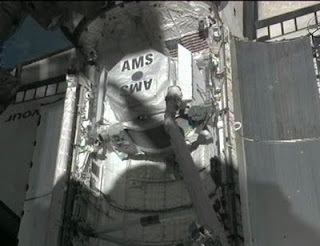 |
| (Image Credit: NASA) |
Shuttle Commander Mark Kelly and pilot Johnson will fly Endeavour for docking with the International Space Station today. An hour before docking, the shuttle will make what NASA nicknamed a “backflip” while the crew take as many pictures as they can of Endeavour's heat shield for analysts to examine.
After docking it is planned that the crew, consisting of Kelly and Johnson, shuttle Mission Specialists Michael Fincke, Greg Chamitoff, Andrew Feustel and the European Space Agency’s Roberto Vittori will join the ISS crew at 8:36 a.m EST (13.36 GMT) for twelve days of experiments and maintenance work. These will include looking at cellular biology, radiation, plant growth and aging, how diet may affect night vision and how an electronic device can check air quality in spacecraft.
Waiting to meet them are ISS Commander Dmitry Kondratyev and Flight Engineers Andrey Borisenko and Alexander Samokutyaev of Russia, Paolo Nespoli of the European Space Agency, and NASA's Cady Coleman and Ron Garan.











